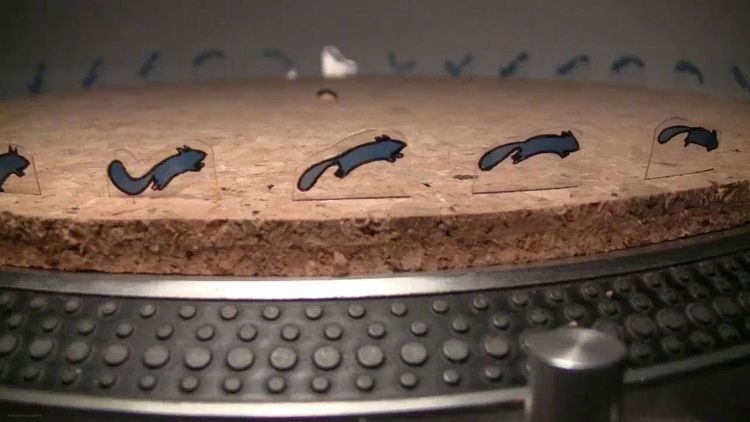 | ||
The Phonotrope is the term coined by Animation Director Jim Le Fevre to describe the technique to create animation in a 'live' environment using the confluence of the frame-rate of a live action camera and the revolutions of a constantly rotating disc, predominantly (but not exclusively) using a record-player.
Contents
It is a contemporary reworking of the Zoetrope, one of several pre-film animation devices that produce the illusion of motion by displaying a sequence of drawings or photographs showing progressive phases of that motion.
The crucial difference of the Phonotrope technique is that it is specifically an in-camera technique using the frame-rate of a live-action camera set to a high shutter speed in confluence with a constantly rotating disc to create the illusion of movement as opposed to the vertical slits in a Zoetrope or the flashes of a stroboscope to create the 'interruptions' needed to create the illusion of movement. As such it can only be seen through either the camera's viewfinder, a connected monitor or projector or viewed as footage after the event.
From its inception the most commonly used methods of rotating the disc have been using a record-player however the technique of using the confluence of frame-rate and revolutions has been applied to a variety of spinning objects from bicycles to pottery wheels.
Although the technique uses the live-action camera to 'parse' or interpret the animation it does not necessarily mean that it is solely a 'film' based process watched remotely on a screen as many iterations of it have formed the heart of installations and performance pieces.
Early examples
The Phonotropic technique appears to have been discovered independently at different times around the world with a variety of different creators only posting their efforts at later dates.
Chuuu, a Japanese painter and VJ, posted his Guruguru Kun Turntable Animation (2005) in 2010.
The artist and filmmaker Eric Dyer's "Copenhagen Cycles" (2006) posted on Vimeo in 2010.
Jim Le Fevre's talk at the Victoria and Albert Museum (2007) posted on YouTube in 2008.
DJ and VJ duo Sculpture's performance at the Elevator Gallery, London, July 18, 2008 part one & part two.
Film director and music producer, Mike Relm , used the Phonotropic technique at the heart of his music video 'Mike Relm vs Zoetrope' posted on YouTube in 2009.
Creative house Legs created a 12 foot high Phonotropic tower for the fashion house Temperley in 2009
Clemens Kogler created the film "Stuck In The Groove" around 2010, an entirely live performance with all video effects performed using a video mixing desk mixing between two record decks.
Film maker and food specialist Alexandre Dubosc created the film "Alimation" in 2011 using Phonotropic sculptures made almost entirely out of food.
Naming
The term Phonotrope was coined in 2010 by Jim Le Fevre having previously termed his version of the technique the Phonographanstasmascope as a nod to the convoluted names of other early forms of pre-film animation such as its ancestor the Zoetrope, the Praxinoscope and the Zoopraxiscope and realised it was too cumbersome to use.
Other terms for the technique have been used throughout its history including Clemens Koglers Phonovideo.
Live event
Eric Dyer is an artist, filmmaker, experimental animator, and educator. Although grounded in screen based animation he started to make his phonotropic discs (or 'zoetropic sculptures') to specifically make films but began to show the discs almost as a "work in progress/presentation, behind the scenes". In 2007 he exhibited a series of paper Phonotropic discs as an installation at the Sundance New Frontier Artist Exhibition, Park City, UT. In 2008 he exhibited more complex 3D printed phonotropic discs in an installation called "Bellows" at SIGGRAPH in Los Angeles, CA, a precursor to his later film "The Bellows March".
Sculpture are "an opto-musical agglomerate". They are Dan Hayhurst (music) and Reuben Sutherland (visuals) and have been performing as early as 2007. Performance is central to their work as Hayhurst creates a soundscape using a variety of analogue and digital sources Sutherland performs accompanying visuals using numerous Phonotropic discs introducing them whilst changing the revolutions of the turntable and position of the decks under the camera and camera view in reaction to the unfolding soundscape. Sutherland has been evolving the Phonotropic technique to harness the revolutions of a reel-to-reel tape recorder which interestingly adds an extra element to the performance by both using the audio from the device as part of the soundscape as well as having the both reels rotating at gradually increasing and decreasing speeds as the length of tape changes.
Katie Turnbull is an Australian visual artist, based in Sydney. In her show at her exhibition "Modern Vantias" in 2012 she used multi-layered Phonotropes, created using printed clear perspex discs, thus managing to give the illusion of three-dimensional forms moving within the two dimensional planes.
Short films
In 2006 Eric Dyer created the film "Copenhagen Cycles" using Phonotropes created out of printed and cut card and in 2009 made the film "The Bellows March" out of 3D printed hand painted Phonotropic discs.
Alexandre Dubosc has been making food based phonotropic based films since 2011. "Alimation" (2011), "The Caketrope of Burton's Team" (2012) and "Phytopage" (2013).
In advertising and broadcast
In 2007 Jim Le Fevre used the Phonotropic technique to create an onscreen ident for MTV called "MTV - Turntable" and in 2010 he created a 2 meter tall Terry Gilliam inspired Phonontrope for the title sequence for the BBC television comedy film Holy Flying Circus. In 2013 Le Fevre (with Rupert and Alice Johnstone from RAMP ceramics) created a phonotropic film using a pottery wheel for the Crafts Council of England.
In 2009 the fashion house Temperley London commissioned Transmedia company Legs to interpret their Spring 2010 collection through an enormous Phonotropic tower. The tower toured both the US and the UK being shown in conjunction with the Temperley fashion shows.
In 2012 EDF Energy created a Phonotrope to advertise their "Thank Yous" campaign.
